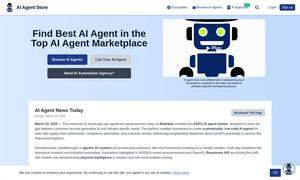
Discover the Best AI Tools to Boost Your Productivity
Find the Best AI Tools to Optimize Your Work and Personal Tasks
Best Voice & Speech AI Tools in 2024

What is Voice & Speech
The Voice & Speech Category encompasses advanced technologies designed to enhance communication through voice interaction. Its primary purpose is to empower users with seamless speech recognition, synthesis, and natural language processing. Standout features include real-time transcription and customizable voice options, enhancing accessibility and user experience.
How Voice & Speech works
The Voice & Speech Category functions through state-of-the-art technologies such as speech recognition tools that convert spoken language into text and speech synthesis systems that generate lifelike voice outputs. Users begin by selecting specific applications or platforms that incorporate these technologies, then input voice commands or dialogue to facilitate interaction. Best practices include careful customization of voice parameters and utilizing user feedback to optimize performance and ensure accuracy in understanding and responding to speech.
What are the advantages of Voice & Speech?
The advantages of the Voice & Speech Category are numerous, highlighting its efficiency and practicality in various applications. Users benefit from time-saving speech recognition and real-time communication capabilities, making it easier to transcribe meetings or interact with customers. The highly customizable voice options also add a unique dimension, allowing organizations to align their voice technology with brand identity and user preferences.
Key Features for Voice & Speech
Real-Time Speech Recognition
Real-Time Speech Recognition is a standout feature within the Voice & Speech Category, enabling instantaneous transcriptions of spoken words into text. This key functionality benefits users by providing immediate access to information and enhancing communication efficiency across various applications, such as meetings or customer support.
Customizable Voice Options
Customizable Voice Options allow users in the Voice & Speech Category to personalize their voice interactions. This unique feature enhances user experience by offering distinct voice profiles that align with individual preferences or brand identities, fostering a more engaging and relatable communication atmosphere.
Natural Language Processing Integration
Natural Language Processing Integration is a defining feature of the Voice & Speech Category, enabling more human-like interactions. This technology allows systems to understand context and nuances in speech, offering users refined communication experiences that accurately interpret and respond to complex requests.
Use Cases for Voice & Speech?
Use cases for the Voice & Speech Category are extensive, ranging from customer service automation to educational tools. Businesses can implement voice recognition for streamlined customer interactions, while educators can leverage speech synthesis for enhanced learning experiences. These applications effectively address the challenges of accessibility, efficiency, and user engagement, ensuring that communication is straightforward and clear.
FAQs for Voice & Speech
How does Real-Time Speech Recognition benefit businesses?
Real-Time Speech Recognition significantly benefits businesses by streamlining communication, enhancing productivity, and improving customer experiences. By instantly transcribing spoken words into text, it allows teams to capture meeting discussions accurately and respond promptly to customer inquiries, ultimately optimizing workflow and engagement.
What makes customizable voice options impactful in the Voice & Speech Category?
Customizable voice options are impactful in the Voice & Speech Category as they allow users to create a unique and personalized interaction experience. By aligning voice interfaces with specific preferences or brand identities, organizations enhance relatability and engagement, fostering stronger connections with their audience.
How does natural language processing enhance user interactions?
Natural language processing enhances user interactions within the Voice & Speech Category by enabling systems to understand the context and subtleties in speech. This leads to more accurate interpretations and more meaningful exchanges, improving overall communication effectiveness and user satisfaction.
What unique advantage does the Voice & Speech Category offer in terms of accessibility?
The Voice & Speech Category offers a unique advantage in accessibility by providing technologies that cater to individuals with varying needs. Voice recognition and synthesis enable users with disabilities to interact more easily with technology, ensuring that everyone has equal opportunities for communication and engagement.
How does the Voice & Speech Category support education?
The Voice & Speech Category supports education by offering interactive tools that facilitate learning through speech. These technologies enhance classroom experiences by enabling students to engage more effectively with content and aiding educators in delivering personalized learning, ultimately improving educational outcomes.
In what ways do users benefit from the Voice & Speech Category's features?
Users benefit from the Voice & Speech Category's features by accessing efficient communication tools that streamline interactions. From real-time transcription to customizable voice options, these offerings improve accessibility and engagement, ensuring that users can connect effortlessly across various platforms and applications.






